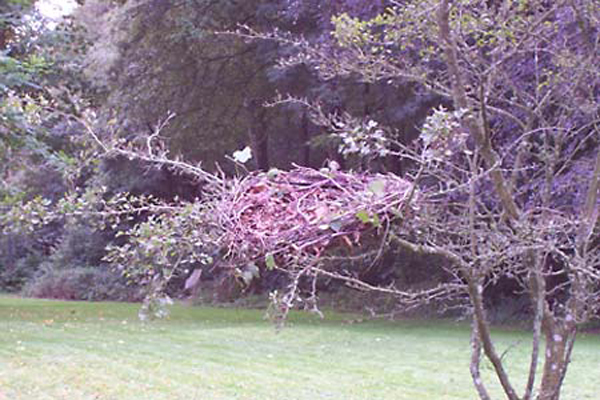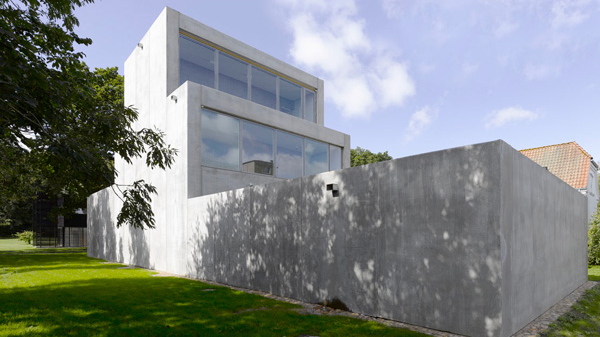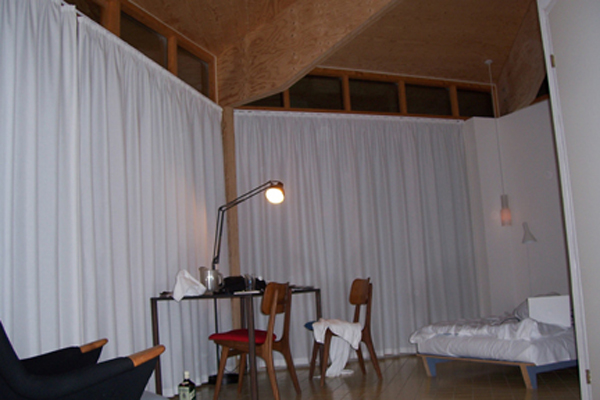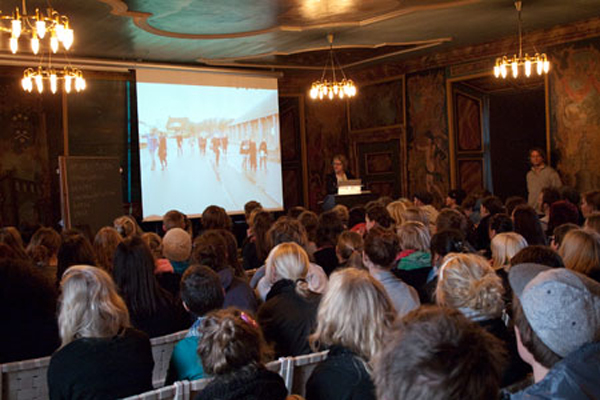Krabbesholm
Keywords: Art School, Chris Kasper, communism, Denmark, education, Krabbesholm, Socialism
Chris Kasper reflects on his time at Krabbesholm, a non-hierarchical school in Denmark where there are no grades, and no degrees.
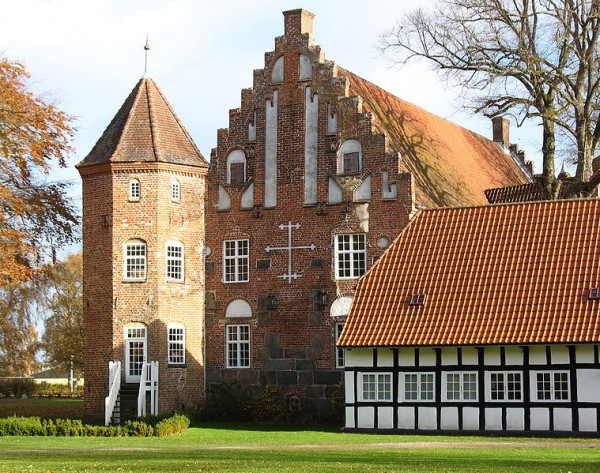
Krabbesholm Manor House. Image courtesy of Krabbesholm.
Krabbesholm Højskole, founded in 1885, is located on the Jutland peninsula of Denmark; about four and a half hours by train northwest of Copenhagen, or about an hour by train northwest of Åarhus, in the Skive Kommune, on the banks of the Skive Fjord. Introducing it this way, as being situated so elegantly, in a pastoral proximity to the larger cities, I can almost hear my friends who teach there, or have been visiting teachers there laughing. I’ve heard the unassuming landscape of Skive, and most of the entire nation of Denmark, described by some Danes (mostly students I’d worked with) as “boring”, “goddamned boring”, or “flat, green hellhole.” I beg to differ. I am not being ironic when I say that Krabbesholm is one of my favorite places in the world, as is Skive. I’m really just a small town kid myself, who regards the fact that I ever left my own hellhole of a hometown, Fredericksburg, Virginia, to somehow be nothing short of a miracle. But in all sincerity, provincial worldviews aside, I believe what is and what has been happening at Krabbesholm to be something rare and special. I’ve had the opportunity to go there twice. Once, for a short residency in 2002, and once as a guest teacher and artist in residence in the Art course for the fall session of 2006. I can only hope the students I worked with there got something of value out of my time as I did of theirs.
…
It was supposed to be an extra large bird’s nest that farted when you walked by it. Or rather fart noises were supposed to come out of it when people passed by. On the day Trine was to present her project for the “site specific” assignment on the Krabbesholm grounds, it rained miserably. She didn’t want to put her boom box, playing the CD with the recording of farts, out in the nest in the soaking rain, and we didn’t want to stand out there in the wet mess to critique it. Trine was bummed. She’d worked for a couple weeks collecting weeds, twigs and sticks, weaving them into this giant nest, that she’d set in this small tree. She’d spent weeks researching farts and recording them. The nest was becoming waterlogged and was beginning to weigh on the tree, and make it droop. She’d pulled an all-nighter and was getting upset, and we discussed other options. Nobody in the class knew this nest-sculpture also had a sound component. What Trine decided to do was have us sit in a group and face out the sliding window-door at the wet nest sagging in the tree. It was looking like it was about to fall over. She didn’t want us to watch what she was doing behind us. So, as we — wearing black bandit masks from another student’s project — stared at the tree, she fumbled around behind us, plugging in the boom box and pressed play. The sound of long wet, disgusting farts shot out of the speakers and filled the room as we stared at the pathetic nest. Almost the same instant the sound of fart hit our ears we all started laughing. We laughed uncontrollably. One woman was laughing so hysterically, that she fell over and started slapping the floor. She picked herself up after a moment, and staggered out of the room, holding her side and nearly tripping over chairs –as if drunk and needing to throw up. It wasn’t simply the sound of farts that prompted this kind of laughter. It was the combination of collective crit-preparation, sleep-depravation, and the awareness of the earnest work put into this project, coupled with the awareness of the ridiculousness of the situation where we were gathered, looking out this window, imagining these farts were somehow coming out of the nest, which was about to fall out of a little tree 50 yards away. This type of special moment is a kind of occurrence in art school that those who have been through it can relate to. The collective sleep deprived madness which fuels strange events that has left many an art student and teacher with a certain feeling that they have just experienced something rare that has not likely happened before, and will never happen again.
Krabbesholm is one of about 76 højskoles in Denmark. Højskole translates in English to folk high school. Højskoles originated in Denmark in the mid-19th century, but have recently spread into Norway, Sweden and Germany.While there are højskoles in other nearby countries, it has been explained to me that the højskole is a particularly Danish model of education. The højskole is a boarding school where students go for a term similar to an academic semester, or even as long as an entire school year in a university in the States. The højskoles are radically different from most American universities or technical schools in that they are organized in non-hierarchical manner, with no official examinations, grades, or degrees rewarded. These models and traditions stem out of 19th century Danish philosopher/theologian Nikolaj Frederik Severin Grundtvig Grundtvig’s ideas of pedagogy. About 65% of the school’s income comes directly from the state.* Students tend to be 18-24, in between high school and university, but older students do attend as well. Højskoles tend to be oriented around a range of subjects from science, to music, to sociology, humanities, or athletics. Krabbesholm is dedicated to the study of art, architecture and design. I’m very grateful for my time residing and teaching there, as it was a completely different pedagogical model than I was used to in the states. I learned a great deal and was inspired by its model of education.
The students I worked with most directly at Krabbesholm tended to be around 17 to 27. Living on campus, I gradually started talking with students before my official times were slotted to co-teach with Peter Bach Nicolaisen, the full-time art teacher on campus. The art studios were along the gravel path on the way back to the Pardo house where I was staying. There is not a lot to do there as a visiting teacher-with the exception of having time to focus on your own work and read, so I would make a point of stopping in the studios in the evening after dinner before retiring to Pardo house, for my nightly rituals I’d developed of reading and writing with a tall glass of whiskey, while listening to ravens scream in the woods behind me as it got dark. It was a little awkward at first, but the students and I started talking with each other weeks before I started working with them in an official “class time” capacity. It was a nice way to break the ice for me. I would attend some of Peter’s, or the visiting photography teacher Fie’s, class discussions, which were conducted mostly in Danish. In the studios after dinner, we would have casual conversations in English and I was able to get a sense of what the students where thinking about, and answer questions about living in New York, and be able to talk to them about artists and movements they may or may not have been aware of. It was a good way for us to be in conversation with each other before I assumed role of “teacher”.
Each morning there was a daily assembly at 8:30 where a faculty member would make a presentation, which was then followed by a presentation from a student. On my first visit in 2002, they were still keeping up with the tradition of singing Danish folk songs. I was sad to see this had come to a stop when I returned in 2006. There was no explicit requirement for me to be there every morning, but Peter, who had invited me to come to Krabbesholm, had told me “it would be a good idea” if I came every morning. So I did. The assemblies were almost always entirely in Danish, so I would rely on the visual materials as well as the manner in which people where speaking to get some sense of what was being discussed. On my first assembly, Peter introduced me, in Danish, I felt some sort of relief to hear my name pronounced, only to lose that relief when the entire school looked at me, to which I waved sheepishly back. The assemblies were mostly interesting. Sometimes there would be visiting speakers who would make long-winded talks with an occasional image of a graph, which in spite of the language barrier, I was able to correctly interpret as boring.
Sometimes the assemblies would erupt with laughter, which was so intense, I’d have to participate in, even though I had no idea what it was I’d joined in laughing about. Students would air grievances and occasionally debate issues concerning the affairs of the school and how it affected them. Peter’s talks were usually my favorite. Even though he was the art teacher, his presentations were usually about music or some other topic that didn’t appear to have an immediate relationship to visual art. One morning he showed the Benny Hill snooker bit, which was a riot. I’m honored to say that Peter tells me he still shows some of the weird, random clips and images I send him. After the morning assembly, the teachers would go down to have some breakfast before the class meetings would start. The students usually would finish breakfast before. The meals there were first come, first serve, but the students were always mindful to leave something for the teachers. Breakfast usually consisted of dark grainy breads, a few different types of ham, some rhubarb or berry preserves, organic soft white cheese and yogurt. To this day, I cannot remember ever having eaten institutional food that good. I definitely fattened up on that visit. It was during the meals where I got to know and develop friendships with the other teachers. They were all very generous making some conversation in English with me at meals.
After a few days of eating, I realized that while there was an official cook in the kitchen, students would work in rotating groups, with a rotating teacher to prepare and serve the meals, and chip in to clean up after. Mealtime seemed to provide structure to the school-both in terms of scheduling, but also establishing something less hierarchical than any institutional setting I’ve been involved with. The students are not simply served by staff. They participate in the preparation of the food and it’s cleanup. Teachers are involved with this process, helping to organize the students, but also getting their own hands involved with the designated kitchen staff. While the teachers eat in the same hall with all the students, some segregation does occur between them and the students. Teachers tend to sit with each other, and students tend not to sit at the teachers table. However, I found interesting that the staff, which provide services to the school that are not explicitly pedagogical (the groundskeepers, kitchen staff and maintenance, etc.) sit together with the teachers. I’ve not been in any other school situation where I’ve witnessed this before, but it says a lot about how workers are regarded; how labor is valued there. I’ve never been at a faculty lunch here in the states, where professors, visiting artists and adjuncts sat and ate with university maintenance workers. There are clear class divisions, even at the most progressive American institutions. At Krabbesholm I was really taken by the way service workers appear to be granted a more even level of respect as the teachers. I’ve never seen anything like that in the states in any institution, where class and career distinctions are more severely delineated and even segregated.
After being there for a few weeks, making a routine of going to the morning assembly, breakfast, back to Pardo house to read and write (or go back to sleep) and then back for lunch, back to Pardo house and then maybe a walk along the fjord before dinner, finishing my day with a visit to the studios, the school chartered a double decker bus and made a field trip to the Bauhaus in Dessau, and then to Berlin for a week. This was good because I was starting to develop an uncanny feeling that Krabbesholm was the only place in the world. I was also given an emergency health insurance card, to verify I was a guest of the school and would be covered in the event of any medical emergency in Germany. Imagine that! Krabbesholm also provided me with a generous stipend for the week, as well as a private room in a hostel with my own bathroom. This wonderful treatment was granted to me simply by virtue of being a guest of the school. I do not have any kind of academic or art “star” status now, and I certainly did not then.
We traveled all night and arrived in Dessau for a tour of the Bauhaus the next morning. No one slept much the night before, and the entire student body and teachers kind of stumbled around in sleep-deprived giddiness. We got back on the bus and arrived in Berlin, on the far west side, in Charlottenburg around four. I crashed early that night and woke up early the next day, and made it downstairs, After breakfast, we held a morning assembly in the courtyard of the hostel, and made plans to split up into groups. I went with Peter and a group of mostly art students. We went to the Neue Nationalgalerie where we looked at and discussed the Berlin-Tokyo/Tokyo-Berlin exhibition, and then went to the Hamburger Bahnhof, where we saw and talked about Hans Peter Feldmann, Beuys and Nauman. This was a great opportunity to speak with the students. We had conversations about art which felt something closer to peer conversations, than the strictly student-teacher conversations I’d had back in the states. Later that night I had dinner with the teachers, and the next day we split into groups again and went to galleries in Kreuzberg and Mitte. Some fiends of mine were running a small exhibition space in Mitte and had a performance the next night. That day I invited the students to come with me and a few did. After the performance we all went to the beer garden in Mitte. I got a little drunk and for a few moments, I thought I was on Bedford Ave. It was getting late and I wanted to get back to my room and crash, but the students I was with insisted I go to some techno show in Potsdamer Platz. When we got there, most of the entire student body was there, drinking and dancing and we were all happy to see each other. Suddenly, it was around four and I learned the hard way that trains in Berlin don’t run all night. I ended up taking a cab back (very cheap, and a Mercedes) and felt the dread of having to get on the bus at 10 to head back to Skive, back to Krabbesholm. On the bus, the next morning, I had to deflect good-natured ribbing from the students about how “crazy” I was dancing, and had to explain to the evening to teachers, who reacted with laughter and stories of their own wild times over the years with students in trips to Berlin, London and Paris.
When we got back to Krabbesholm, I still had a week and a half before I was supposed to teach. It was better being there after having broken the ice with the students in Berlin. I settled back into the feeling that Krabbesholm was the only place in the universe. The studio conversations became more interesting and less serious. Architecture and design students started talking to me as well. We’d talk about art and film and show each other things on the Internet in the design studios. I realized the students ran a weekly bar in the Grundtvig House (a building where some design classes where held and a lot of the social functions the students would organize where held) on Friday nights. Matthew, the other American visiting the school, and I were encouraged by some of the full time staff to hang out .We started screening films in the Gruntvig House and I felt ready to teach my first workshop on site-specific sculpture. The anxiety I’d felt about teaching in English to Danish students when I’d first arrived had gone. I felt different going into this class compared to others I’d taught in the states. I was never really conscious of any “authority” preparing a class, getting ready the night before it started, but I was definitely conscious of going into this class without a feeling that I was instructing these students, so much as just being aware of and excited to work with them.
When the class started, we already had a sense of knowing each other. I felt a sense of rapport with the students that usually takes at least a semester to develop. Some things were not that different than teaching sculpture in the states. Teaching a class in a studio doesn’t really loan itself to lecturing or other authoritarian modes of pedagogy. This was the case here. I sat on the edge of a table; students sat on the edges of other tables a few chairs and the floor. Peter was there to help me out if what I was talking about needed translating. While the topic of the class was site-specific sculpture, some students where making drawings or collages which was fine. We talked about those too. It gave me a small bit of anxiety at first, but the realization that I was not required to give a grade or evaluation, that the students were not required to do what assigned them was actually liberating. I found myself having to work a little harder to prove that what I had to teach was interesting and worth their time. When I’d taught in the states before, it was with a type of authority — that came from knowing I would make evaluations and assign grades. I had not examined the implications of this authority before working without it. I noticed those burdens of making assessments lift and I felt my methods of teaching that I had been developing over a couple years, (which I had also not examined much before) beginning to loosen and lift. I approached the class in more of a collaborative sense, rather than an instructive one. We looked at images of site-specific works. Students showed images of things they were interested in. What was not different from the classes I’d taught in the states was mixing talking as a group and then talking individually. As students where starting to get their projects together, an excitement of the yearly Krabbesholm reunion party, started to creep into the way they were working. Every year the alumni from previous years come back for an epic weekend-long party. The day we were to present the site-specific projects, was the same day former students started arriving, along with board members of the school. The students were excited. So was I.
The first chill of fall was in the air, and my class was presenting their first projects for a class I was teaching, not only to the entire school, but also for years of alums who were returning for a weekend long reunion party. There was a buzz in the air. For starters, two of the site-specific projects coincided with the morning assembly and meal. One of the students, Katrine, made a project where she’d cut out black fabric bandit-style masks and asked everyone to put one on before starting the morning assembly. Another student, Asger, had snuck into the morning assembly room and rearranged all the chairs into a stage-like cube wrapped in red and white tape, which is used by the nation of Denmark to block off construction or accident sites. Being that this room, is a very old room covered with old murals, in the main 500 year old building on campus where the daily assemblies where held, both of these projects worked to conjure some spirit of mischief. While the seats were unavailable, and the entire student body -with most teachers, were dispersed to the walls in bandit masks, Kurt Finsten addressed the school regarding the festivities of the weekend while everyone attempted to suppress giggles. The breakfast following the morning assembly was charged with extra giddiness and excitement with the coming party, the momentary coup that happened with the chairs in the room and everyone wearing the ridiculous bandit masks. Breakfast finished, and it started raining. We had to discuss the rest of the projects in the rain. Three students, Ditte, Emilie, and Sophie, collaborated on a performance/endurance work, where the walked back and forth, in the rain for 24 hours to make a foot-trodden path in the lawn for a shortcut from the end of the dorms to the studios. As far as I know, their path still exists today. The day went by quickly looking at and interacting with the projects.
The end of my first class had commenced with that critique, as people started arriving. I took a short nap and had a shower, and made it to the dinning hall, which was full of good-natured rowdy Krabbesholm alums who were drinking beers, waiting for dinner to begin. It was laid out on the tables, two roasted pigs with apples in their mouths, potatoes, black seedy bread, rolls, white cheese, spinach, fresh salad, roasted root vegetables, some other roast meats and beer. The dinner finished, everyone chipped in and the dining hall was turned into a dance floor. Some DJs from Copenhagen came up and played a range of music from ’80s pop, to electronic, to old Danish folk, and Ah-Ha several times that night. For some reason Ah-Ha seemed to bring everyone out to dance. I took notice that pretty much all of the students were enjoying the party and dancing. I didn’t see the sulking-in-the-corner-bitching-about-how-the-music-sucks types I was familiar with in art schools in the states. I hung out with and talked with the other teachers, drank and smoked, and decided to bow out a little early to save a little dignity and energy for the big party the following night. On the way out, some of my students were outside smoking, and I joined them. They brought up the class enthusiastically. One student, a young woman, started giving me a slight drunken rant about George Bush and “your country”, asking me what the hell was wrong with Americans. I told her that we were all stupid and lazy, which made her laugh, but we went on to continue conversations about politics during the rest of my time there. I was genuinely impressed with the fact that she, and many of the young students here seemed much more engaged with global politics than many of my peers back home. I staggered back to room and retired for another day of it on Saturday.
The Performance workshop was met with a cool reception at first, but it picked up. Being on campus around the clock opened up the opportunity for really frightening, supernaturally tinged pieces to occur in the middle of the night. One involving a student reading Milton to a tree on campus during on overnight thunderstorm, and another where a couple students lead us through the woods in search of The White Lady, one of a few legendary ghosts who supposedly dwell on campus grounds. The autumn had settled in and it was time for me to get back to New York. I had learned a lot at Krabbesholm, but I did not realize how much until I had the opportunity to teach again in the states. Students here are definitely much more driven by competition, and the competitive environment of art school is palpable. Not only as a teacher, but also as a student, I’ve experienced American art schools to be a place where there is some room for experimentation and failure, but there is also a hyper-awareness of art magazines and an attempt to produce work that appears “ready” to be exhibited — even at the undergraduate level. What I experienced at Krabbesholm was something less bombarded by awareness of the market, or pressure to make a career. Of course this does come in part from it’s being a short program. There is less of a continuum of what one class of students does to the next. Without an emphasis on evaluation and grading, It’s not unlike some well-known residencies here in the states, situated in bucolic settings; only the student body tends to be younger, less savvy and driven by the desire to “network”. The requirement for students to participate in the day-to-day labor of preparing meals and such is not a trivial part of the students developing some sense of self-discipline with regards to what is being learned. It is a quiet and small place where wonderful things are being shared, taught and learned.
* percentages provided by Kurt Finsten, Director of Krabbesholm
